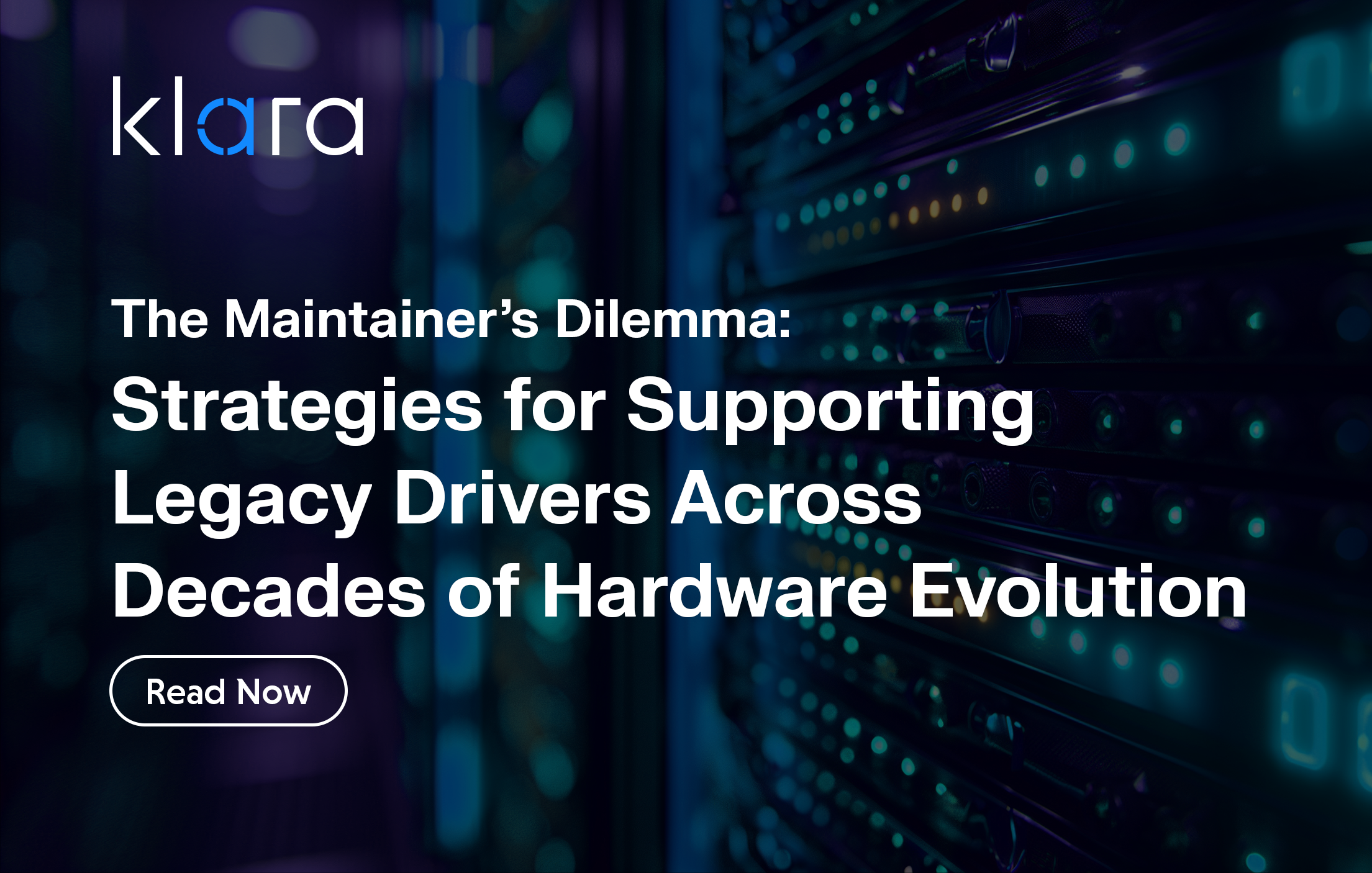Unlock the power of your datacenter with ARM.
Klara’s ARM and Embedded Software Development Team intelligently applies modern design methodologies and agile development best practices to firmware development from bare metal systems to multi-processor architectures.
Embedded Development Contact UsAdditional Articles
Here are more interesting articles on Embedded that you may find useful:
- The Overlooked Complexity of Firmware Security in the IoT Era
- Why FreeBSD is the Right Choice for Embedded Devices
- Looking Towards the Future: FreeBSD on the RISC-V Architecture
- RISC-V: The New Architecture on the Block
- FreeBSD arm64 Performance – Getting more out of your FreeBSD Deployment
The fundamental paradox of driver maintenance presents itself: as hardware architectures evolve at an accelerating pace, the software layer interfacing with them must simultaneously maintain backward compatibility while embracing technological advancement. This technical exploration examines the multifaceted challenges of supporting legacy drivers across hardware evolution timescales measured in decades rather than years and presents architectural strategies that have proven effective in real-world implementations.
Drivers represent a unique class of software that straddles the boundary between hardware abstraction and operating system integration. Unlike application software, drivers must contend with both API/ABI compatibility requirements from the operating system above and hardware interface changes from below. This dual constraint creates what we term the "maintainer's dilemma" – the increasingly complex challenge of supporting legacy hardware without inhibiting innovation or compromising system stability.
The Technical Foundations of the Maintainer's Dilemma
ABI Stability vs. Interface Evolution
At the core of legacy driver maintenance lies the requirement for Application Binary Interface (ABI) stability. Unlike API compatibility, which concerns source-level interfaces, ABI compatibility ensures that binary modules compiled against older specifications continue functioning with newer kernel versions without recompilation.
The Linux kernel's approach illustrates the technical complexity involved. While userspace ABI stability is sacrosanct (as Linus Torvalds has repeatedly emphasized with his "we don't break userspace" doctrine), internal kernel interfaces face no such constraint. This dichotomy creates significant technical debt when supporting legacy drivers that may depend on deprecated internal interfaces.
The EXPORT_SYMBOL_GPL and EXPORT_SYMBOL macros delineate this boundary, with the former marking interfaces exclusively for GPL-compatible modules, while the latter designates stable interfaces that maintain compatibility guarantees.
By contrast, FreeBSD only guarantees ABI stability within a major version branch. A binary compiled for FreeBSD 14.0 will work on FreeBSD 14.4, but may not work on 15.0. However, the API is much less likely to change gratuitously, and a source driver written for 12.x will likely still compile and work on 15.x.
In Windows, the Windows Driver Model (WDM) evolved into the Windows Driver Frameworks (WDF) and most recently the Universal Windows Driver (UWD) model, yet Microsoft has maintained remarkable backward compatibility through sophisticated interface versioning and internal compatibility layers. The Windows Driver Kit (WDK) incorporates mechanisms such as INF decoration with Needs directives that enable fine-grained control over which driver model versions a specific driver requires.
Hardware Abstraction Layer Evolution
The hardware-side interface presents an equally challenging dimension. Modern System-on-Chip (SoC) designs may radically alter traditional assumptions about device access methods. Consider the evolution from memory-mapped I/O with dedicated IRQs to complex integrated controllers with shared interrupt controllers and layered DMA subsystems.
Legacy drivers often implement hardware access patterns optimized for architectures that have long since been superseded:
/* Legacy direct port I/O approach */
outb(command, device_port);
while (!(inb(status_port) & READY_BIT))
cpu_relax();
result = inb(data_port);
Such polling-based I/O patterns become problematic in modern power-managed systems where CPU cores may enter deep sleep states, or where virtualization adds significant overhead to direct I/O operations.
Architectural Strategies for Long-Term Driver Maintainability
Layered Driver Architecture
The most successful long-term driver maintenance strategy involves implementing a layered architecture that decouples hardware-specific code from OS-specific interfaces. This approach consists of three distinct layers:
- Hardware Abstraction Layer (HAL) - Provides a uniform interface to varying hardware implementations
- Functional Driver Layer - Implements device-specific logic independent of hardware variations
- OS Interface Layer - Adapts the functional layer to OS-specific driver models
This separation allows for targeted updates when either hardware interfaces or OS driver models evolve, without requiring a complete rewrite. The FreeBSD CAM (Common Access Method) subsystem exemplifies this approach for storage drivers, with a clearly defined separation between the SIM (System Interface Module) and the peripheral drivers.
Similarly on the networking side, FreeBSD has iflib, a common library of interface functionality that is shared by many NIC drivers in FreeBSD. This greatly reduces the time it takes to develop new drivers by avoiding recreating common boiler plate and cuts down the maintenance burden when the kernel interfaces do change. With the kernel specific parts of the driver abstracted into the common library, they only need to be changed once, instead of in each driver.
Version-Aware Interface Design
Embedding explicit version information in driver interfaces enables graceful degradation when newer systems interact with legacy drivers. The technique of "interface versioning" involves:
- Embedding an explicit version field in all interface structures
- Implementing version detection in interface handlers
- Providing fallback paths for older interface versions
There are a few important factors to consider when building a versioned interface or data structure. Along with a version number that will allow the other side of the interaction to correctly interpret the data, the size of the data structure must be considered, especially if multiple messages will be passed per call. To maintain maximum flexibility, it can be beneficial to include “padding” members in data structures, that in future versions can be used to pass additional data, without changing the data structure in ABI breaking ways.
Another approach, used by VirtIO, the paravirtualized drivers that accelerate guest hardware in modern hypervisors, is to use “feature flags”. When different virtualization stacks might support different subsets of features across different releases, it is helpful to clearly delineate what is supported and what is not, where it couldn’t easily be expressed as a single monotonically increasing version number.
Inside the drivers, the hardware is queried to determine what features it supports, and then the correct data structures are passed back and forth. This allows a single unified driver to support an array of different iterations of the hardware.
Compatibility Wrappers and Shims
For cases where interface evolution is unavoidable, compatibility wrappers provide a technical solution that preserves binary compatibility while allowing core interfaces to evolve. These "shim layers" translate between legacy and modern interfaces.
When a call comes in via the old API, the wrapper can translate the data structure into the new format, and call the modern API, then convert the result back to the expected format when returning. This maintains the old ABI without requiring newer drivers to be constrained to the limited functionality of the original ABI.
Microsoft's approach with Windows driver compatibility is particularly instructive. The implementation of the IoGetDeviceProperty() function has evolved substantially since Windows NT, yet drivers compiled against Windows 2000 DDKs still function on Windows 11 due to sophisticated internal interface versioning and compatibility thunks.
Virtualization as an Isolation Strategy
When hardware architectures change so fundamentally that direct compatibility becomes impossible, virtualization offers a technical escape hatch. Operating systems increasingly employ transparent virtualization for legacy drivers, isolating them from the rest of the system.
macOS's transition from PowerPC to Intel and subsequently to ARM architecture leveraged this approach extensively. The Rosetta translation layer in combination with IOKit driver abstractions allowed legacy drivers to function in a virtualized environment without modification, with the hypervisor mediating hardware access.
Case Study: Network Driver Evolution
The evolution of Ethernet drivers from 10Mbps through 100Gbps and beyond illustrates these principles in practice. Intel's e1000e driver series has maintained compatibility across two decades of hardware evolution through a combination of:
- A consistent register layout abstraction that maps newer hardware capabilities to established patterns
- A hardware abstraction layer that isolates device-specific initialization sequences
- Versioned feature negotiation that allows older drivers to function with reduced capabilities on newer hardware
Examining the code evolution from the original e1000 driver to the modern ice driver reveals how this architectural approach has accommodated the transition from discrete components to highly integrated network controllers with sophisticated offload capabilities. It also explains why so many hypervisors choose the e1000 driver to emulate, as it is supported by legacy operation systems, but can take advantage of significant offload features on modern systems.
Conclusion: Forward-Looking Strategies for Driver Maintainers
As heterogeneous computing and specialized accelerators become prevalent, the maintainer's dilemma will only intensify. Emerging strategies to address these challenges include:
- Driver Synthesis - Machine learning techniques that automatically generate hardware adaptation layers based on specification and observation
- Interface Contracts - Formal specification of driver interfaces with runtime verification to detect compatibility violations
- Fault-Tolerant Driver Frameworks - Isolation mechanisms that contain driver failures while providing graceful degradation
The most successful approach combines technical solutions with procedural discipline. Google's Fuchsia OS exemplifies a forward-looking approach with its FIDL (Fuchsia Interface Definition Language) that enforces strict versioning and compatibility testing for all driver interfaces.
For organizations maintaining legacy drivers, implementing a comprehensive compatibility testing infrastructure becomes essential. Automated validation across hardware generations with documented compatibility matrices provides the foundation for sustainable long-term driver support, transforming the maintainer's dilemma from an intractable problem into a manageable engineering challenge.
Get access to expert advice and experienced developers with Klara’s Driver Development services to ensure your hardware and driver are well supported long into the future.






